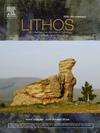Alkaline magmatism in the post-orogenic Triassic Predazzo complex, Dolomites, NE Italy: Ages and significance
IF 2.9
2区 地球科学
Q2 GEOCHEMISTRY & GEOPHYSICS
引用次数: 0
Abstract
The Predazzo pluton (Predazzo–Monzoni intrusive complex, Dolomites) is a multipulse calc-alkaline–shoshonitic body, which was emplaced at 238.075 ± 0.087 Ma to 235.9 ± 1.8 Ma. On the eastern flank of the pluton, smaller-volume alkaline rocks are also found, but their relationships with the main magmatic products are not well understood. New field, petrographic, geochemical and geochronological data indicate that these alkaline rocks infilled a small volcano-tectonic trough and consist of trachytic lavas and volcanoclastic tephra (V2 unit), studded by small monzonite and syenite bodies (MS unit) in mingling-mixing relationships, yielding ages of 238.1 ± 1.8 to 230.1 ± 0.6 Ma. Phonotephrite to phonolite dykes (MF unit) crosscut the entire volcanic sequence at 215.0 ± 0.3 Ma and 203 ± 1 Ma. The alkaline cycle thus developed soon after and, possibly, during the main calc-alkaline–shoshonitic stage. Lamprophyric dykes (camptonites) were also emplaced from 234.5 ± 0.3 to 219.2 ± 0.7 Ma. Whole-rock compositions suggest that the magmas enriched in asthenospheric component that produced the lamprophyres could generate the MS–V2 and MF magmas by Assimilation-Fractional-Crystallization, involving assimilation of various carbonatic and silicic crustal components. The very rapid passage from the “post-orogenic” calc-alkaline–shoshonitic to the “anorogenic” alkaline affinity in the Middle-Late Triassic thus appears to reflect a continuous transition within the same geodynamic context, characterized by the gradual development of extensional structures, representing the prodrome of the Jurassic rifting, and progressively deeper magma sources, rather than a sudden change in the regional geodynamic regime.
求助全文
约1分钟内获得全文
求助全文
来源期刊

Lithos
地学-地球化学与地球物理
CiteScore
6.80
自引率
11.40%
发文量
286
审稿时长
3.5 months
期刊介绍:
Lithos publishes original research papers on the petrology, geochemistry and petrogenesis of igneous and metamorphic rocks. Papers on mineralogy/mineral physics related to petrology and petrogenetic problems are also welcomed.
 求助内容:
求助内容: 应助结果提醒方式:
应助结果提醒方式:


